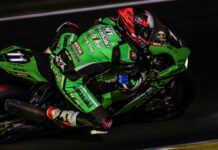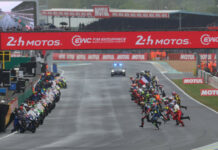The Holy Grail for people who design armor—all kinds of armor—is protection with comfort. Designing armor—be it body armor, helmets, or boots—seems to be a zero-sum game. More protection comes from greater mass, which causes its own problems in motorcycle road racing applications. Here’s why: Greater mass usually means greater thickness and less flexibility. This can be bad if you are trying to pilot a road racing motorcycle at a high rate of speed. It’s been a little disheartening to encounter resistance when trying to get other racers to try riding with a chest protector, for example, but I understand the objection. If it interferes with a racer’s perception of comfort and control, it’s a non-starter. One way around this conundrum would be to find a product that is thick enough to offer the needed protection, yet flexible enough to allow the racer or track-day rider to get on with the job at hand. To date, most companies have sought this compromise through articulated panels on back protectors and simply forming elbow, shoulder, knee and hip protection into the shape needed when the rider is on the bike. Leatt has come up with another approach, a high-tech solution to the protection/flexibility contradiction that has its roots in military research applications. The company says its new “perforated, multilayer, 3DF AirFit impact foam offers a soft and flexible fit, yet instantly transforms into a harder, energy-absorbing protector upon impact.” If that sounds like a miracle, it’s not. The principle is well-established. Non-Newtonian materials—also known as shear-thickening fluids or dilatants—are relatively soft when not stressed, but “lock together” at the molecular level when subject to impacts, turning a relatively pliable material into something much, much stiffer. Some refer to the material as “rate-resistant” or “rate-reactive” or having “intelligent molecules.” I much prefer either of the former to the latter. Many school students perform an experiment demonstrating this principle with a solution of corn starch and water. A student can easily plunge their extended, flat hand into the solution, but when punched with a closed fist, that same solution acts like a solid. On YouTube, you can find a video from “The Ellen Degeneres Show” in which an audience member easily plunges her arm into a tub of a corn starch and water solution, then walks across the tub of the solution without sinking. For years, researchers looking for better military body armor have sought the benefits of non-Newtonian materials; something flexible enough to allow a soldier to be more comfortable in normal conditions that would stiffen when struck by a bullet and prevent the projectile from piercing the armor. Companies like Dow Corning and BAE Systems have been experimenting with such materials, which use silica particles as the protective solid. In the civilian market, one of the first products designed to exhibit such characteristics was marketed under the name of Astrene, a green, gel-like material which was also incredibly soft ordinarily, but became rigid under impact, says Paul Varnsverry, Technical Director of PVA Technical File Services Limited in England and an internationally recognized expert in the field of motorcycle body armor safety standards. “Astrene could be used in incredibly thin thicknesses, compared with other materials. It was quite dense, therefore heavy and incredibly expensive, and so did not gain traction in the market,” Varnsverry says. A Sussex, England-based company known as D3O Impact Protection has been marketing STF body armor for several years for various applications, including motorcycle protective gear. Leatt’s interpretation of the non-Newtonian armor concept is known as 3DF. While the original 3DF foam material was made of a single layer, Leatt found that using multiple thin layers built up to about 12mm (0.47-inch) in thickness allowed much greater flexibility, making the garment much more comfortable for the wearer. Leatt’s 3DF AirFit Body Vest features a 3DF back protector and a chest protector incorporated into a compression vest. The vest zips around the left side of the chest and offers a pair of adjustment straps to help hold it in place. The company says the vest material is a moisture-wicking fabric that keeps the wearer cooler, and that the armor is removable to allow the vest to be washed. I removed the armor from the chest region, all right, but not to wash the vest. The potential here almost sounds too good to be true; lightweight, flexible armor that would conform to my torso as if it were customized for me, yet still offer the protection I want from body armor. I was able to slowly squeeze the material between my fingers to about half its regular thickness, maybe a bit thinner. I could easily fold it in half, taco-style. Then, lacking any other testing device, I threw that stuff flat on the concrete garage floor, grabbed a dead-blow hammer and whacked it hard—hard enough that my wife Sandy heard the impact from the far side of the house. (I gotta start warning her when I do this kind of research.) The foam deflected far, far less than I anticipated—a millimeter or so, I would estimate. Multiple blows from the dead-blow hammer at the same spot in rapid succession failed to create any greater deflection. Just to double check, I grabbed two pieces of shipping foam I found inserted inside the pocket of a new jacket that’s meant to hold a real back protector. I laid them atop one another and whacked relatively gently—and heard the head of the dead-blow hammer hitting the concrete as if the “protective foam” wasn’t even there. I went back to smacking the 3DF, harder and harder. The difference between hitting the two materials was like night and day. The company has certified the chest protector to the CE prEN1621-3 Level 2 impact standard—the highest proposed for chest protection. The back protector is certified to the CE EN1621-2 Level 2 impact standard—the highest standard in existence. In use, the vest went on easily, fit comfortably under my leathers and never intruded upon my riding during a full day of track-day adventures at Auto Club Speedway. I really, really like the compression vest/armor combination. It just went on in the morning and came off when I was done for the day. Other than that, it was like wearing a shirt. Honestly, claims for the impact absorption material sound like magic. But I can say that the vest was one of the most comfortable pieces of body armor I’ve ever worn, and the material really was astounding during the hammer-whacking test. The only feedback I would offer to the company is that it could take more advantage of the flexibility of the material, perhaps making the back protector longer and the chest protector wider. Suggested retail for the 3DF AirFit Body Vest is $199. For more information, contact Leatt Corp., Dept. RW, 26475 Summit Circle, Santa Clarita, California, 91350, (661) 287-9258, www.leatt-brace.com.
PRODUCT FEATURE: Leatt 3DF AirFit Body Vest
PRODUCT FEATURE: Leatt 3DF AirFit Body Vest
© 2013, Roadracing World Publishing, Inc.






